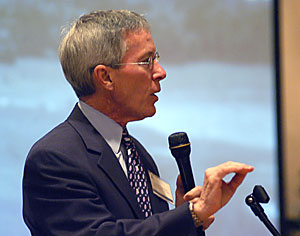 |
|
DJAMILA NOELLE GROSSMAN/Arizona Daily Wildcat
|
UA professor of law and public policy Robert Glennon stressed the importance of groundwater conservation especially in Arizona during the 20th Annual Agribusiness Forum on Urbanization and Agriculture yesterday in Mesa.
|
|
|
By Djamila Noelle Grossman
Arizona Daily Wildcat
Wednesday, February 23, 2005
Print this
MESA .- Questions about urban sprawl in the Salt River Valley, space for agriculture and water use in Arizona were addressed at yesterday's 20th annual Arizona agribusiness forum on urbanization and agriculture.
Dean Lueck, a professor of agriculture and resource economics, said the conference attempted to give an overview of the urban and agricultural situation because they impact each other and need to be talked about.
"Urbanization is a huge fact of life in Arizona," Lueck said. "You can't avoid the issue in a state that's growing so fast."
Tom Rex, associate director at the center for business research at Arizona State University, said there is a contradiction between the rapid population growth of the Phoenix area and the economic situation. While job opportunities were good in the 1930s, and employers turned to immigrants to fill their positions, the situation has now turned, he said.
"Job growth just isn't there. It's not allowing a number of people to settle here," Rex said.
He said it is unclear how the population could still be growing, with fewer jobs available each year. At the moment the population in the Phoenix area has a population increase of 150,000 a year, Rex said.
"There's something out of whack here," Rex said.
Thomas Sheridan, professor of anthropology at the Southwest Center, addressed the history of Arizona's agriculture and said there has always been a struggle between water use for agricultural and urban purposes.
Until World War I, Arizona was rich in agricultural diversity and then turned to cotton monoculture. The population started to grow after World War II, he said.
Farmers wanted to turn desert scrubs, land covered with small trees and shrubs, into irrigated fields, and soon started looking for water transported from the Colorado River, Sheridan said.
"Colorado River water became the holy grail of Arizona politics. Water always remained a problem and agriculture consumes about 80 percent of Arizona's water," Sheridan said.
However, he said because the Colorado River carried less water than expected, it became so expensive that farmers couldn't afford it.
"What started as a farmer's dream to make the desert bloom, ended up being an urbanization boom," Sheridan said. "Even though Arizona has (some of) the best agricultural land in the U.S., it is rapidly turned into urbanized land."
Alvin Sokolov, public policy specialist at the University of California Davis, said there is a clear distinction between protecting agricultural areas for environmental and economic reasons, but they do overlap. It is important for agriculture to contribute to the diversity of local economy, he said.
Other topics included ranch values, state land issues, conservation policies and a national perspective on urbanization and agriculture.
Jennifer Nelkin, a graduate student in plant science, said she came to the conference because she is interested in urban agriculture, specifically having greenhouses in a city.
"This was perfect because there are so many conferences on biotechnology and stuff like that, but never on this topic," Nelkin said.
